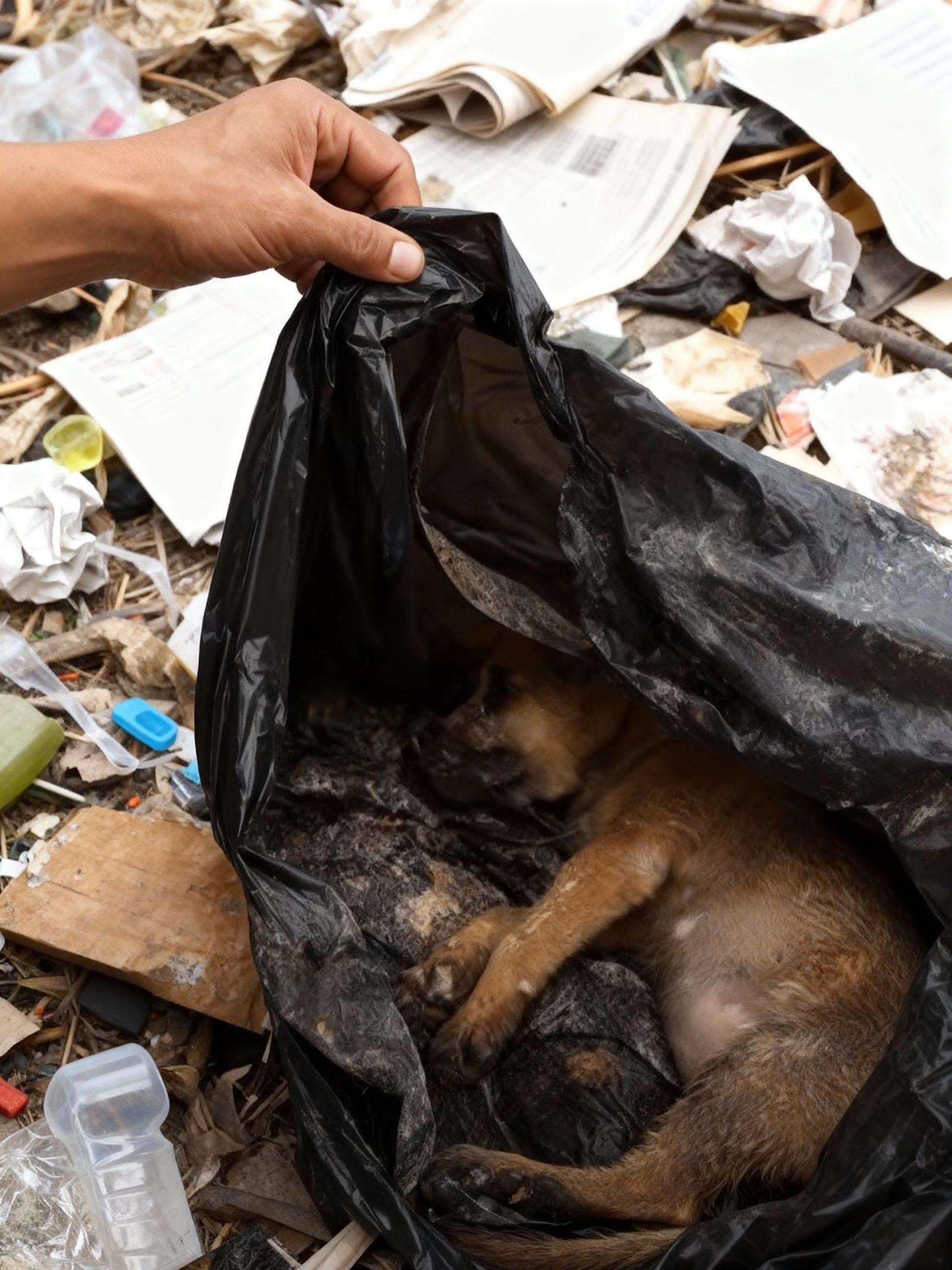The image before us is a stark, heart-wrenching tableau that compels immediate attention and deep reflection. It captures a moment of profound vulnerability and neglect: a tiny, defenseless puppy, seemingly discarded and resting in a black plastic bag amidst a refuse-strewn environment, its small form a silent testament to a tragic reality many animals face daily. A human hand gently holds open the bag, hinting at discovery, perhaps even a glimmer of hope, but the prevailing mood is one of desolation. This single frame encapsulates the dire consequences of animal abandonment—a widespread issue that silently plagues communities globally, often hidden from plain sight, yet leaving an indelible mark on countless innocent lives. The puppy’s fragile state, surrounded by the detritus of human consumption, serves as a poignant metaphor for how easily life, particularly non-human life, can be devalued and cast aside. It challenges us to look beyond the immediate shock and delve into the complex layers of responsibility, empathy, and societal structures that contribute to such distressing scenes. This image is not just a photograph; it is an urgent call to conscience, a visual plea for advocacy, and a stark reminder that the welfare of animals is inextricably linked to the ethical fabric of our society. It forces us to confront uncomfortable truths about our collective treatment of creatures who share our world, urging us to consider the systemic failures and individual choices that lead to such profound suffering.

The issue of animal abandonment is multifaceted, stemming from a variety of factors including economic hardship, irresponsible breeding, lack of awareness regarding pet care, and a general disregard for animal welfare. In many cases, pets are acquired on impulse, often as gifts or during festive seasons, without a full understanding of the long-term commitment and resources required. As these animals grow, or as owners face unexpected life changes, they may find themselves overwhelmed, leading to the heartbreaking decision to discard their once-cherished companions. This cycle perpetuates a devastating reality for countless animals, who are left to fend for themselves in harsh environments, often succumbing to starvation, disease, or injury. The innocence reflected in the puppy’s slumber, juxtaposed with the squalor of its surroundings, amplifies the tragedy, highlighting the stark contrast between the care these animals deserve and the cruel hand fate deals them. It is a profound failure of human empathy and responsibility when a life, dependent and trusting, is so carelessly cast aside. The narrative of animal abandonment is a silent epidemic, unfolding in alleys, parks, and desolate stretches of land, far from the public eye yet deeply impactful. These animals, once part of a home, are suddenly thrust into a world for which they are ill-equipped, forced to forage for sustenance and shelter, constantly vulnerable to the elements and human cruelty. Their suffering is a direct consequence of human choices, underscoring the urgent need for greater accountability and compassion in our communities.

The repercussions of animal abandonment extend far beyond the immediate suffering of individual animals. From an ecological perspective, abandoned pets can disrupt local ecosystems, competing with native wildlife for resources or, in some cases, preying on vulnerable species. They can also contribute to the spread of diseases, posing risks to both other animals and humans. Socially, the presence of neglected animals can lead to public health concerns, generate nuisance complaints, and reflect poorly on the ethical standards of a community. The burden often falls on already overstretched animal shelters and rescue organizations, which struggle with limited resources to cope with the influx of abandoned animals. These organizations often operate on shoestring budgets, relying heavily on volunteers and donations to provide care, rehabilitation, and rehoming services. The image of the helpless puppy in the trash bag serves as a potent symbol of this systemic strain, highlighting the urgent need for robust community support and proactive solutions to mitigate the problem. The hidden costs of abandonment are significant, both in terms of animal welfare and the resources required to address its consequences. Every abandoned animal represents a challenge to public health, safety, and the moral fabric of a society that values compassion.

Preventing animal abandonment requires a multi-pronged approach that encompasses education, legislation, and community engagement. Educational campaigns can raise awareness about responsible pet ownership, emphasizing the financial, time, and emotional commitments involved in caring for an animal throughout its life. These campaigns can also promote the importance of spaying and neutering to control pet overpopulation, a significant contributor to abandonment rates. Legislation can play a crucial role by establishing stricter penalties for animal cruelty and abandonment, while also promoting mandatory pet registration and identification programs. Community initiatives, such as low-cost veterinary services, pet food banks, and temporary foster programs, can provide support to pet owners facing economic difficulties, offering alternatives to abandonment. The image of the abandoned puppy underscores the urgent need for such interventions, highlighting how simple acts of neglect can lead to profound suffering. Collective responsibility is paramount in addressing this issue. Every individual has a role to play, from advocating for stronger animal protection laws to supporting local shelters and rescue groups.







